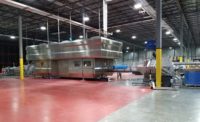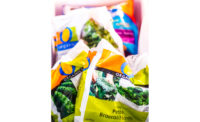The market for high-pressure processing (HPP) equipment is projected to reach $500.3 million by 2022, at a CAGR of 11.26% from 2016, according to “High Pressure Processing Equipment Market by Orientation Type (Horizontal and Vertical), Vessel Volume, Application (Fruits & Vegetables, Meat, Juice & Beverages, Seafood), End User Category, and Region - Global Forecast to 2022,” a report published by MarketsandMarkets, New York.
The study also outlined that fruits and vegetables accounted for the largest share in the application of HPP equipment in 2015, with United States dominating the geographic market.
Factors such as increased consumption of packaged foods, a rise in ready-to-cook meat production, government assistance toward developing food technologies and a widening applicability of HPP equipment are key drivers in the growth of HPP equipment, in addition to the already cemented uses of promoting food safety and extending shelf life.
“The purpose of pasteurization is two-fold—first to provide a method of food safety, and also to extend shelf life,” says Dr. Errol Raghubeer, senior vice president, HPP science and technology for Avure Technology, Erlanger, Ky. “Over the last few years, many alternative methods to heat pasteurization have been explored, including HPP, pulse electric field (PEF) processing, ohmic heating, UV light and radiation. Compared to other methods, HPP has the most advantages, being feasible and cost-effective in most situations, maintaining taste, texture and nutrition while providing a clean label. Plus, HPP machines are relatively easy to fit into most production lines.”
In addition, a new survey of Americans currently employed in the refrigerated and frozen food industry indicates strong appreciation for the role HPP plays in producing safe foods with cleaner labels and longer shelf lives. The online industry survey, commissioned by Universal Pasteurization Co. LLC (UPC), Lincoln, Neb., shows that more than half of the survey respondents (59%) were familiar with HPP, and 57% characterized their companies’ use of the technology as some, growing or substantial. Almost no one indicated any level of dissatisfaction with HPP within their organizations, and survey takers also believed their retail and foodservice customers were usually favorably disposed to HPP, but often unaware if or when it was being utilized.
“With HPP, food and beverage producers can sleep better at night knowing their food is safer. Recalls can of course be costly, if not fatal, to a brand’s value,” says Jeff Barnard, president of UPC. “In addition, the increased shelf life from HPP allows for expanded distribution. For retailers, this shelf life will result in lower shrink, meaning less product that needs to be thrown away. This can help reduce operating costs and support companies’ efforts to operate in more environmentally conscious ways.”
For example, Deli Star Corp., Fayetteville, Ill., made slight modifications to its packaging and upgraded steam and electricity to withstand additional capacity through its post-pasteurization process units, says Mike Weber, director of operations.
“Deli Star’s R&D team is continuously researching additional [applications] for post-pasteurization,” adds Weber. “We are currently developing sliced deli meat products and prepared protein and sauce meals that will maintain product quality after post-pasteurization.”
Deli Star is also revamping its AMVAC line of fresh meat products, which come in a vacuum skin package that maintains the fresh red color of meat. This environmentally-friendly packaging is said to be more freezer-friendly than other case-ready packaging formats, can go directly into the freezer without repackaging and reduces the risk of freezer burn and other deterioration.
New technologies advance food safety
While the basic HPP systems have been around for some time, today’s equipment manufacturers continue to develop more enhanced versions that boast flexibility and speed.
For example, Avure’s expandable HPP machine “features a large-diameter vessel that uses the largest capacity baskets available to maximize throughput,” says Raghubeer.
Dubbed the AV-X series, the upgradable machines feature a flexible design with a smaller footprint to suit individual production needs. Other attributes include newly-designed intensifiers, easier-to-maintain parts and large-diameter vessels built to accommodate larger, bulky or odd-shaped packages and provide easier load outs.
In response to growing business demands, Green Plant LLC, Miami, Fla., installed its second Hiperbaric HPP machine in six months. The Hiperbaric 525 system, manufactured by Hiperbaric USA, also in Miami, is said to accommodate 10 times the capacity as the first HPP machine. Green Plant is also dubbed to be the first and only Florida-based company with an HPP machine capable of producing 4 million bottles of cold-pressed juice per month.
Meanwhile, TRUE FRESH HPP installed its third Hiperbaric 525 machine in its innovation center in Buena Park, Calif., making it what is said to be the single largest concentration of HPP tolling services under one roof in Northern America.
“HPP is an equivalent method to thermal pasteurization without the heat,” says Jamie Nicolás-Correa, director of Hiperbaric. “It is a post-packaging kill step to avoid the risk of decontamination.”
Multivac Inc., Kansas City, Mo., continues to upgrade its portfolio with new pasteurization technologies.
“While the basic HPP system has been around, we continue to develop thermoformed vacuum and modified atmosphere packaging (MAP) with the appropriate geometries, materials and seal profiles to survive the stress of high pressure,” says Cem Yildirim, market development sales manager.
To keep up with the rapid expansion of HPP brands, Lineage Logistics, a Colton, Calif.-based warehousing and logistics company sponsored by Bay Grove Capital LLC, San Francisco, added a second HPP machine to its Mira Loma, Calif., location, and a third one in its Allentown, Pa., facility.
“The new Mira Loma machine increased our total capacity by 20%, enabling us to take on new channels of business like foodservice, as well as new product lines like pet food,” says Tim Smith, executive vice president, sales and business development. “In the next few years, we foresee a rapid expansion of HPP into store brands, as retailers try to keep pace with the national brands and meet consumer demand for healthier products. We also foresee HPP growing significantly in the foodservice industry, especially in the quick-serve sector, for similar reasons. These technologies continue to grow because they satisfy trends we do not foresee fading with time; they help to retain the flavors and colors of fresh foods, and they give manufacturers and processors the ability to create the new and innovative food propositions that consumers, particularly the Millennial generation, are looking for.”
Go to http://bit.ly/1L8ZurQ to learn more about these and other HPP technologies.









